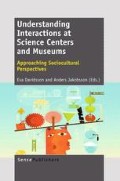Abstract
Many university graduate programs have come to recognize the value of teacher interactions and have systematically planned these networking opportunities in their courses of study. Throughout the United States, and many locations internationally, primary and middle level teachers are being required to pursue discipline specific endorsements for subjects they are assigned to teach exclusively. This chapter will provide a detailed description of a science professional development program that is collaboratively administered by a science centre and a university and targets the learning of subject matter, pedagogy and curriculum within subject specific museum exhibits.
Access this chapter
Tax calculation will be finalised at checkout
Purchases are for personal use only
Preview
Unable to display preview. Download preview PDF.
REFERENCES
Allen, S. (2002). Looking for learning in visitor talk: A methodological exploration. In G. Leinhardt, K. Crowley, & K. Knutson (Eds.), Learning Conversations in Museums (pp. 259–303). Mahwah, NJ: Lawrence Erlbaum.
American Association for the Advancement of Science. (1990). Science for all Americans. New York: Oxford University Press.
American Association for the Advancement of Science. (1993). Benchmarks for science literacy. New York: Oxford University Press.
Anderson, R.D. (2007). Inquiry as an organizing theme for science curricula. In S.K. Abell & N.G. Lederman (Eds.), Handbook of research on science education (pp. 807–830). Mahwah, NJ: Lawrence Erlbaum.
Anderson, D., Kisiel, J., & Storksdieck, M. (2006). Understanding teachers’ perspectives on field trips: Discovering common ground in three countries. Curator: The Museum Journal, 49 (3), 365–386.
Birman, B. F., Desimone, L., Porter, A. C., & Garet, M. S. (2000). Designing professional development that works. Educational Leadership, 57 (8), 28–33.
Cox-Peterson, A.M., Marsh, D.D., Kisiel, J., & Melber, L.M. (2003). Investigation of guided school tours, student learning, and science reform recommendations at a museum of natural history. Journal of Research in Science Teaching, 40 (2), 200–218.
Falk, J.H., & Dierking, L.D. (1992). The museum experience. Washington, DC: Whalesback.
Falk, J.H., & Dierking, L.D. (2000). Learning from museums: Visitors experiences and their making of meaning. Walnut Creek, CA: Altamira Press.
Ferry, B. (1993). Science centers and outdoor education centers provide valuable experience for preservice teachers. Journal of Science Teacher Education, 4 (3), 85–88.
Ferry, B. (1995). Science centers in Australia provide valuable training for preservice teachers. Journal of Science Education and Technology, 4 (3), 255–260.
Garet, M. S., Porter, A. C., Desimone, L., Birman, B. F., & Yoon, K. S. (2001). What makes professional development effective? Results from a national sample of teachers. American Educational Research Journal, 38 (4), 915.
Griffin, J. (1994). Learning to learn in informal settings. Research in Science Education, 24, 121–128.
Griffin, J. (1999). An exploration of learning in informal settings. Paper presented at the National Association for Research in Science Teaching Annual Conference, Boston, MA.
Griffin, J., & Symington, D. (1997). Moving from task-oriented to learning-oriented strategies on school excursions to museums. Science Education, 81 (6), 763–779.
Illinois State Board of Education (1997). Illinois learning standards for science. Springfield, IL: Illinois State Board of Education.
Jarvis, T., & Pell, A. (2005). Factors influencing elementary school children’s attitudes toward science before, during, and after a visit to the UK national space centre. Journal of Research in Science Teaching, 42 (1), 53–83.
Hein, G.E. (1998). Learning in the museum. New York: Routledge.
Hein, G.E. (1999). The constructivist museum. In Hooper-Greenhill, E. (Ed.), The Educational Role of the Museum (pp. 73–79). New York, NY: Routledge.
Kelly, J. (2000). Rethinking the elementary science methods course: A case for content, pedagogy, and informal science education. International Journal of Science Education, 22 (7), 755–777.
Kisiel, J. (2005). Understanding elementary teacher motivations for science fieldtrips. Science Education, 89, 936–955.
Loucks-Horsley, S., Love, N., Stiles, K., Mundry, S., & Hewson, P. (2003). Designing professional development for teachers of science and mathematics (2nd ed.). Thousand Oaks, CA: Corwin Press.
National Research Council. (1996). National science education standards. Washington, DC: National Academy Press.
Oppenheimer, F. (1973). Everyone is you…or me. In M. Quinn (Ed.), Sharing science: Issues in the development of interactive science and technology centres (p. 1). London: Nuffield Foundation in Association with the Committee on the Public Understanding of Science.
Orion, N., and Hofstein, A. 1994. Factors that influence learning during a scientific field trip in a natural environment. Journal of Research in Science Teaching, 29 (8): 1097–1119.
Phillips, M., Finkelstein, D., & Wever-Frerichs, S. (2007). School site to museum floor: How informal science institutions work with schools. International Journal of Science Education, 29 (12), 1489– 1507.
Russell, R.L. (1996). The role of science museums in teacher education. Informal Science Review, 19, 16.
Shulman, L.S. (1986). Those who understand: Knowledge growth in teaching. Educational Researcher, 15 (2), 4–14.
Stevens, R., & Hall, R. (1997). Seeing Tornado: How video traces mediate visitor understandings of (natural?) phenomena in a science museum. Science Education, 81 (6), 735–47.
Storksdieck, M. 2001. Differences in teachers’ and students’ museum field-trip experiences. Visitor Studies Today 4 (1): 8–12.
Wayne, A. J., Yoon, K. S., Zhu, P., Cronen, S., & Garet, M. S. (2008). Experimenting with teacher professional development: Motives and methods. Educational Researcher, 37 (8), 469.
Author information
Authors and Affiliations
Editor information
Rights and permissions
Copyright information
© 2012 Sense Publishers
About this chapter
Cite this chapter
Lederman, J.S., Hollyday, G.M., Lederman, N. (2012). The Impact of Exhibit-Based Professional Development on Teachers’Pck. In: Davidsson, E., Jakobsson, A. (eds) Understanding Interactions at Science Centers and Museums. SensePublishers. https://doi.org/10.1007/978-94-6091-725-7_7
Download citation
DOI: https://doi.org/10.1007/978-94-6091-725-7_7
Publisher Name: SensePublishers
Online ISBN: 978-94-6091-725-7
eBook Packages: Humanities, Social Sciences and LawEducation (R0)


